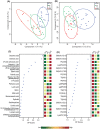Roux-en-Y Gastric Bypass Surgery Induces Early Plasma Metabolomic and Lipidomic Alterations in Humans Associated with Diabetes Remission
- PMID: 25946120
- PMCID: PMC4422729
- DOI: 10.1371/journal.pone.0126401
Roux-en-Y Gastric Bypass Surgery Induces Early Plasma Metabolomic and Lipidomic Alterations in Humans Associated with Diabetes Remission
Abstract
Roux-en-Y gastric bypass (RYGB) is an effective method to attain sustained weight loss and diabetes remission. We aimed to elucidate early changes in the plasma metabolome and lipidome after RYGB. Plasma samples from 16 insulin-resistant morbidly obese subjects, of whom 14 had diabetes, were subjected to global metabolomics and lipidomics analysis at pre-surgery and 4 and 42 days after RYGB. Metabolites and lipid species were compared between time points and between subjects who were in remission and not in remission from diabetes 2 years after surgery. We found that the variables that were most discriminatory between time points were decanoic acid and octanoic acid, which were elevated 42 days after surgery, and sphingomyelins (18:1/21:0 and 18:1/23:3), which were at their lowest level 42 days after surgery. Insulin levels were lower at 4 and 42 days after surgery compared with pre-surgery levels. At 4 days after surgery, insulin levels correlated positively with metabolites of branched chain and aromatic amino acid metabolism and negatively with triglycerides with long-chain fatty acids. Of the 14 subjects with diabetes prior to surgery, 7 were in remission 2 years after surgery. The subjects in remission displayed higher pre-surgery levels of tricarboxylic acid cycle intermediates and triglycerides with long-chain fatty acids compared with subjects not in remission. Thus, metabolic alterations are induced soon after surgery and subjects with diabetes remission differ in the metabolic profiles at pre- and early post-surgery time points compared to patients not in remission.
Conflict of interest statement
Figures



References
-
- Sjostrom L, Narbro K, Sjostrom CD, Karason K, Larsson B, Wedel H, et al. Effects of bariatric surgery on mortality in Swedish obese subjects. N Engl J Med. 2007; 357: 741–752. - PubMed
-
- Jørgensen NB, Jacobsen SH, Dirksen C, Bojsen-Møller KN, Naver L, Hvolris L, et al. Acute and long-term effects of Roux-en-Y gastric bypass on glucose metabolism in subjects with Type 2 diabetes and normal glucose tolerance. Am J Physiol Endocrinol Metab. 2012; 303: E122–E131. 10.1152/ajpendo.00073.2012 - DOI - PubMed
Publication types
MeSH terms
Substances
LinkOut - more resources
Full Text Sources
Other Literature Sources
Medical
Research Materials

